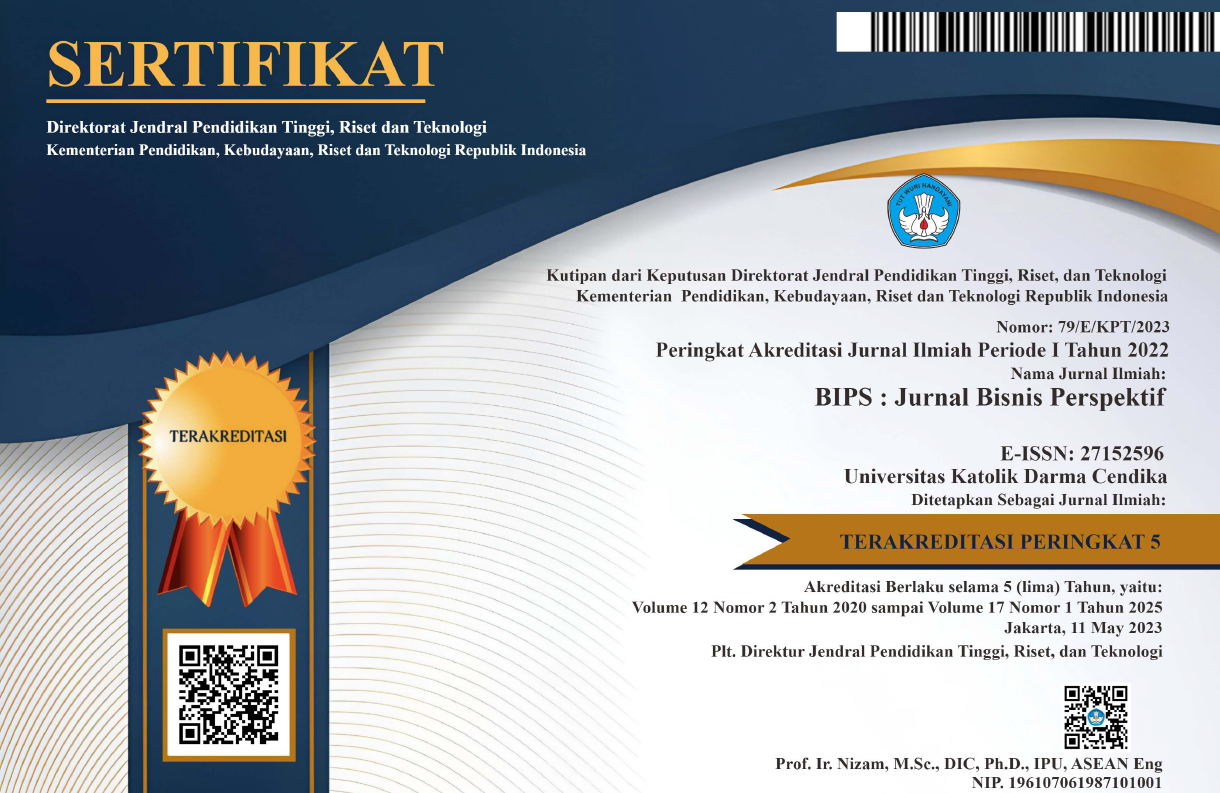PENGARUH PERCEIVED OF BENEFIT DAN E-TRUST TERHADAP MINAT MENGGUNAKAN QRIS
DOI:
https://doi.org/10.37477/bip.v15i2.443Keywords:
perceived benefits, e-trust, consumer interest, QRIS.Abstract
This study aims to examine whether there is an influence between perceived benefits and e-trust on the intention to use QRIS. The data collection technique in this study was by using non-probability sampling with the method of determining the sample, namely judgment sampling or purposive sampling techniques. The number of respondents in this research are 155 respondents. Furthermore, the collected data has been tested for construct validity and reliability and processed using SEM (Structural Equation Modeling) analysis. To test the construct validity of exogenous variables, researchers use the value of the loading factor. As for the reliability test, the researcher used the Cronbach Alpha value. Researchers have also conducted a model fit test to ensure that the research model used is included in the very good category (fit). The results of this study indicate that perceived benefit and e-trust have a positive and significant effect on interest in using QRIS. The results of this study also show that the millennial generation can accept new innovations created by digital payment applications.
References
Berraies, S., K. Ben Yahia, & M. Hannachi. 2017. Identifying The Effects of Perceived Values of Mobile Banking Applications on Customers: Comparative Study between Baby Boomers, Generation X and Generation Y. International Journal of Bank Marketing, Vol. 35, No. 6, pp. 1018-1038.
Corritore, C. L., B. Kraccher, & S. Wiedenbeck. 2003. On-line Trust: Concept, Envolving Themes, A Model. International Journal of Human Computer Studies, Vol. 58, No. 6, pp. 737-758.
Dachlan, U. 2014. Panduan Lengkap Structural Equation Modeling (Tingkat Dasar).
Edisi Pertama. Penerbit Lentera Ilmu. Semarang.
Effendy, F. 2020. Pengaruh Perceived of Benefit Terhadap Niat Untuk Menggunakan Layanan Dompet Digital Di Kalangan Milenial. Jurnal Interkom, Vol. 15, No. 2, pp. 44-54.
Ghane, S., M. Fathian, & M. R. Gholamian. 2011. Full Relationship Among E- Satisfaction, E-Trust, E-Service Quality, and E-Loyalty Case of Iran E-Banking. Journal of Theoretical and Applied Information Technology, Vol. 33, No. 1, pp. 1- 6.
Houston, D. D. 2019. Adopsi Penerimaan Digital Payment Pada Kalangan Milenial.
Jurnal Medium, Vol. 7, No. 2, pp. 55-67.
https://data.tempo.co/data/1316/e-wallet-jadi-alat-pembayaran-digital-terpopuler-di- 2021.
Kasih, S. S. & N. N. K. Moeliono. 2020. Pengaruh E-Service Qaulity dan E-Trust Terhadap E-Loyalty Dengan E-Satisfaction Sebagai Variabel Intervening (Studi Pada Pelanggan Sorabel di Bandung). Jurnal Ilmiah Mahasiswa Ekonomi Manajemen, Vol. 5, No. 4, pp. 780-791.
Kim, J., H. C. Lee, & H. J. Kim. 2004. Factors Affecting Online Search Intention and Online Purchase Intention. Seoul Journal of Business, Vol. 10, No. 2, pp. 27-48.
Lu, Y., S. Yang, P. Y. Chau, & Y. Cao. 2011. Dynamics Between The Trust Transfer Process and Intention to Use Mobile Payment Services: A Cross-Environment Perspective. Information & Management, Vol. 48, No. 8, pp. 393-403.
Mayer, R. C., J. H. Davis, & F. D. Schoorman. 1995. An Integrative Model of Organizational Trust. Academy of Management Review, Vol. 20, No. 3, pp. 709- 734.
Nawangsari, S. & N. D. Putri. 2020. Pengaruh E-Service Quality dan E-Trust Terhadap Kepuasan Nasabah Pengguna BNI Mobile Banking Melalui Citra Bank Sebagai Variabel Intervening (Studi Kasus Pada Nasabah Pengguna BNI Mobile Banking di Kota Depok), Jurnal Ilmiah Matrik, Vol. 22, No. 1, pp. 55-63.
Ozturk, A. B. 2016. Customer Acceptance of Cashless Payment Systems in the Hospitality Industry. International Journal of Contemporary Hospitality Management, Vol. 28, No. 4, pp. 801-817.
Pekerti, R. I. & V. Briliana. 2016. Pengaruh Perceived Benefits, Perceived Risks, Hedonic Motivations, Psychological Factors dan Website Design Terhadap Online Buying Behavior. Jurnal Bisnis dan Akuntansi, Vol. 18, No. 2, pp. 147-158.
Prakosa, D. & A. Pradhanawati. 2020. Pengaruh E-Trust dan E-Service Quality Terhadap E-Loyalty Dengan E-Satisfaction Sebagai Variabel Intervening (Studi Kasus Pada Pengguna Tokopedia Di Kota Semarang). Jurnal Ilmu Administrasi Bisnis, Vol. 9, No. 4, pp 457-464.
Priyatno, D. 2017. Panduan Praktis Olah Data Menggunakan SPSS. Edisi I. Penerbit Andi. Yogyakarta.
Reichheld, F. F. & P. Schefter. 2000. E-Loyalty: Your Secret Weapon on the Web.
Harvard Business Review, Vol. 78, No. 4, pp. 105-114.
Sumarwan, U. 2011. Perilaku Konsumen. Ghalia Indonesia. Bogor.
Downloads
Published
How to Cite
Issue
Section
License
Authors publishing in this journal agree to the following terms:
- The author retains copyright and grants the journal rights of first publication with the work simultaneously licensed under a Creative Commons Attribution ShareAlike License License that allows others to share the work with acknowledgment of the author's work and initial publication in BIP's: Journal of Business Perspectives.
- Authors may include separate additional contractual arrangements for non-exclusive distribution of the published version of the journal (e.g., submit to an institutional repository or publish in a book), with an acknowledgment of the original publication in this Journal.
- Authors are permitted and encouraged to post their work online (e.g., in institutional repositories or on their websites) before and during the submission process, as it can lead to productive exchanges, as well as citations of previously published work.
Each author is expected to complete the copyright process with a document of the originality of the manuscript, the templated document is below:


7.png)


6.png)
2.png)


